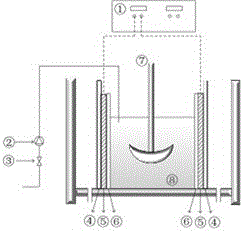Sludge conditioning-horizontal alternating current field dewatering method and device
An AC electric field and sludge conditioning technology, applied in sludge treatment, electrochemical sludge treatment, water/sludge/sewage treatment, etc. The problem of large sludge resistance, etc., can avoid the large resistance of anode sludge, shorten the conditioning time, and improve the dehydration efficiency.
- Summary
- Abstract
- Description
- Claims
- Application Information
AI Technical Summary
Problems solved by technology
Method used
Image
Examples
Embodiment 1
[0039] The sludge to be dewatered treated in this embodiment was collected from a sewage treatment plant in Beijing, and the sewage treatment plant used the A2O process to treat municipal sewage. The activated sludge collection point is located somewhere on the return path from the secondary sedimentation tank to the aeration tank. The sludge concentration (MLSS) reached 13.6g / L, the moisture content was 98.62%, and the pH value was 7.04.
[0040] 1) Put the sludge in the conditioning and dehydration integrated device;
[0041] 2) Turn on the AC power supply, set the effective value of the electrolysis voltage to 5.0V, turn on the mechanical stirrer, and stir the sludge at a stirring intensity of 200 r / min, and add 1.0 g / gVSS of Fe to the sludge at the same time 0 And the potassium persulfate of 0.5 g / gVSS, then continue to stir 70min;
[0042] 3) Turn off the AC power, settle the conditioned sludge by gravity, and then discharge the supernatant;
[0043] 4) Turn on the AC ...
Embodiment 2
[0046] The sludge to be dewatered treated in this embodiment was collected from a sewage treatment plant in Beijing, and the sewage treatment plant used the A2O process to treat municipal sewage. The activated sludge collection point is located somewhere on the return path from the secondary sedimentation tank to the aeration tank. The sludge concentration (MLSS) reached 13.6g / L, the moisture content was 98.62%, and the pH value was 7.04.
[0047] 1) Put the sludge in the conditioning and dehydration integrated device;
[0048] 2) Turn on the AC power supply, set the effective value of the electrolysis voltage to 9.0V, turn on the mechanical stirrer, and stir the sludge at a stirring intensity of 400 r / min, and add 1.0 g / gVSS of Fe to the sludge at the same time 0 And the potassium persulfate of 0.5 g / gVSS, then keep stirring for 50min;
[0049] 3) Turn off the AC power, settle the conditioned sludge by gravity, and then discharge the supernatant;
[0050] 4) Turn on the AC...
Embodiment 3
[0053] The sludge to be dewatered treated in this embodiment was collected from a sewage treatment plant in Beijing, and the sewage treatment plant used the A2O process to treat municipal sewage. The activated sludge collection point is located somewhere on the return path from the secondary sedimentation tank to the aeration tank. The sludge concentration (MLSS) reached 13.6g / L, the moisture content was 98.62%, and the pH value was 7.04.
[0054] 1) Put the sludge in the conditioning and dehydration integrated device;
[0055] 2) Turn on the AC power supply, set the effective value of the electrolysis voltage to 7.0V, turn on the mechanical stirrer, and stir the sludge at a stirring intensity of 300 r / min, and add 1.0 g / gVSS of Fe to the sludge at the same time 0 And the potassium persulfate of 0.5 g / gVSS, then keep stirring for 50min;
[0056] 3) Turn off the AC power, settle the conditioned sludge by gravity, and then discharge the supernatant;
[0057] 4) Turn on the AC...
PUM
| Property | Measurement | Unit |
|---|---|---|
| Concentration | aaaaa | aaaaa |
Abstract
Description
Claims
Application Information
 Login to View More
Login to View More - R&D
- Intellectual Property
- Life Sciences
- Materials
- Tech Scout
- Unparalleled Data Quality
- Higher Quality Content
- 60% Fewer Hallucinations
Browse by: Latest US Patents, China's latest patents, Technical Efficacy Thesaurus, Application Domain, Technology Topic, Popular Technical Reports.
© 2025 PatSnap. All rights reserved.Legal|Privacy policy|Modern Slavery Act Transparency Statement|Sitemap|About US| Contact US: help@patsnap.com



